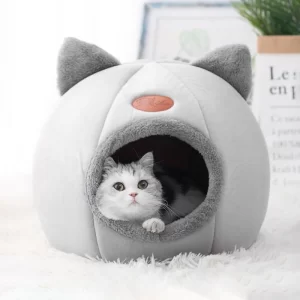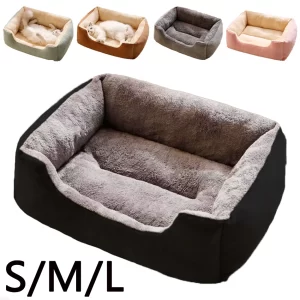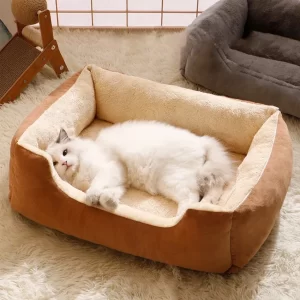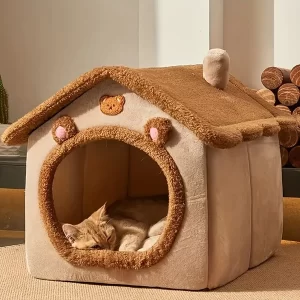A Guide to Choosing the Perfect Pet Bed for Your Furry Companion
 Welcome to the ultimate guide to choosing the perfect pet bed for your furry companion. If you’re a pet owner, you know how important it is to provide your beloved friend with a comfortable and cosy place to rest and relax. But with so many options available, finding the right pet bed that meets your pet’s needs and suits your home decor can be overwhelming.
Welcome to the ultimate guide to choosing the perfect pet bed for your furry companion. If you’re a pet owner, you know how important it is to provide your beloved friend with a comfortable and cosy place to rest and relax. But with so many options available, finding the right pet bed that meets your pet’s needs and suits your home decor can be overwhelming.
In this comprehensive guide, we’ll walk you through the essential factors to consider when selecting a pet bed, from size and material to style and support. Whether you have a small dog, a large cat, or something in between, we’ve got you covered. Our expert tips and recommendations will help you make an informed decision and ensure your furry friend gets a good night’s sleep.
We’ll also address common concerns, such as hypoallergenic options for pets with allergies and the benefits of orthopaedic beds for older pets. So, let’s dive in and find the perfect pet bed that will have your furry companion snoozing in style and comfort in no time.
The Importance of Choosing the Right Pet Bed
If you are a pet owner, you know how much your furry friend loves to sleep and relax. But did you know that the quality and type of pet bed you provide can have a significant impact on their health and well-being? In this article, we will explore some of the benefits of choosing the right pet bed for your pet and some of the factors to consider when purchasing.
Benefits of Choosing the Right Pet Bed
 One of the main benefits of choosing the right pet bed is that it can improve your pet’s comfort and sleep quality. A good pet bed should support your pet’s body and joints, and provide enough cushioning and insulation to keep them warm and cosy. A comfortable pet bed can also reduce stress and anxiety, and promote relaxation and calmness. This can improve your pet’s mood and behaviour, and prevent or reduce common problems such as excessive barking, chewing, or scratching.
One of the main benefits of choosing the right pet bed is that it can improve your pet’s comfort and sleep quality. A good pet bed should support your pet’s body and joints, and provide enough cushioning and insulation to keep them warm and cosy. A comfortable pet bed can also reduce stress and anxiety, and promote relaxation and calmness. This can improve your pet’s mood and behaviour, and prevent or reduce common problems such as excessive barking, chewing, or scratching.
Another benefit of choosing the right pet bed is that it can prevent or alleviate some of the health issues that your pet may face. For example, a pet bed that is too small, too hard, or too cold can cause pressure sores, joint pain, arthritis, or skin infections. A pet bed that is too large, too soft, or too hot can cause overheating, breathing difficulties, or spinal problems. A pet bed that is not cleaned regularly can harbour bacteria, fungi, parasites, or allergens that can cause infections, allergies, or respiratory problems. By choosing a pet bed that suits your pet’s size, shape, weight, breed, age, and health condition, you can prevent or minimize these risks and ensure your pet’s optimal health.
Factors to Consider When Choosing a Pet Bed
When choosing a pet bed for your pet, there are several factors to consider. Some of the most important ones are:
-
-
- Size: The size of the pet bed should match the size of your pet. It should be large enough for your pet to stretch out comfortably, but not so large that they feel lost or insecure. You can measure your pet’s length and width when they are lying down, and add a few inches to each dimension to find the ideal size for their bed.
- Shape: The shape of the pet bed should match the shape of your pet’s body and sleeping style. Some pets prefer round or oval beds that allow them to curl up and feel cosy. Others prefer rectangular or square beds that give them more space and support. Some pets like beds with raised edges or bolsters that provide them with a sense of security and a place to rest their head. Others like beds with low or no edges that allow them to stretch out and move freely.
- Material: The material of the pet bed should match the material preferences and needs of your pet. It should be durable, easy to clean, and resistant to stains, odours, and chewing. It should also be soft, comfortable, and breathable. Some pets like beds made of fleece, cotton, or plush that are warm and cosy. Others like beds made of nylon, polyester, or canvas that are cool and smooth. Some pets like beds filled with foam, memory foam, or orthopaedic foam that provide them with firm support and pressure relief. Others like beds filled with polyester fibre, cotton batting, or cedar chips that provide them with soft cushioning and natural scent.
- Location: The location of the pet bed should match the location preferences and habits of your pet. It should be placed in a safe, quiet, and comfortable spot where your pet likes to sleep and relax. It should also be away from direct sunlight, drafts, heat sources, or noise sources that may disturb your pet’s sleep. You can also consider having multiple pet beds in different locations to give your pet more options and variety.
- Age: The age of your pet can also influence the type of bed you need. Older pets may have joint problems, arthritis, or other health issues that require more support and cushioning. In this case, you may want to look for a bed that has orthopaedic foam, memory foam, or extra padding. Younger pets may be more energetic and playful and may need a bed that is durable, washable, and resistant to chewing or scratching.
- Breed: The breed of your pet can also affect their preferences and needs for a pet bed. Some breeds, such as huskies, malamutes, or other cold-weather dogs, may prefer a bed that is cosy, warm, and fluffy. Other breeds, such as bulldogs, pugs, or other short-haired dogs, may prefer a bed that is cool, breathable, and smooth. You should also consider the temperament and personality of your pet, and choose a bed that suits their style.
-
Choosing the right pet bed for your pet is not only a matter of convenience or aesthetics. It is also a matter of health and happiness. By following these tips and guidelines, you can find the perfect pet bed for your furry friend that will make them feel loved and pampered.
Different Types of Pet Beds – Orthopaedic, Heated, Elevated, and Cave-Style
If you are looking for a new bed for your furry friend, you might be overwhelmed by the variety of options available. Different types of pet beds suit different needs and preferences, such as orthopaedic, heated, elevated, and cave-style beds. Here is a brief overview of each type and its benefits:
-
-
- Orthopaedic beds are designed to provide extra support and comfort for pets with joint problems, arthritis, or injuries. They usually have a thick, memory foam mattress that conforms to the pet’s body and relieves pressure points. Orthopaedic beds can also help prevent joint issues in older or larger pets.
- Heated beds are ideal for pets who get cold easily, especially in winter or in air-conditioned rooms. They have a heating element that warms up the bed and creates a cosy environment for the pet. Heated beds can also soothe pets with muscle pain or inflammation.
- Elevated beds are raised off the ground and have a sturdy frame and a mesh or fabric platform. They allow air circulation under the bed and keep the pet cool and dry. Elevated beds are also easy to clean and resistant to fleas, mites, and mould.
- Cave-style beds are enclosed beds that have a hood or a flap that covers the entrance. They create a sense of security and privacy for the pet, especially for cats or small dogs who like to hide or burrow. Cave-style beds can also block out light and noise and help the pet sleep better.
-
Understanding your Pet’s Sleeping Habits and Preferences
 Pets are more than just companions, they are also members of our families. They have their personalities, preferences, and needs, and that includes how they sleep. As pet owners, it is important to understand our pet’s sleeping habits and preferences, as they can affect their health, behaviour, and well-being.
Pets are more than just companions, they are also members of our families. They have their personalities, preferences, and needs, and that includes how they sleep. As pet owners, it is important to understand our pet’s sleeping habits and preferences, as they can affect their health, behaviour, and well-being.
Different types of pets have different sleeping patterns, depending on their species, breed, age, activity level, and environment. For example, dogs typically sleep for 12 to 14 hours a day, but some breeds may need more or less sleep. Cats usually sleep for 15 to 20 hours a day, but they are more active at night than during the day. Birds tend to sleep for 10 to 12 hours a day, but they need a dark and quiet place to rest. Small animals like hamsters, gerbils, and guinea pigs are nocturnal or crepuscular, meaning they are most active at night or dawn and dusk, respectively.
Pets also have different sleeping preferences, depending on their temperament, comfort level, and security needs. Some pets may prefer to sleep alone, while others may enjoy cuddling with their owners or other pets. Some pets may like to sleep in a cosy bed or crate, while others may prefer a couch or a floor mat. Some pets may need a blanket or a toy to feel safe and comfortable, while others may not.
Understanding your pet’s sleeping habits and preferences can help you provide them with the best care possible. By respecting their natural rhythms and needs, you can ensure that they get enough quality sleep to stay healthy and happy. You can also avoid disturbing their sleep or causing them stress by adjusting your schedule and routine accordingly. By observing your pet’s behaviour and body language, you can learn what they like and dislike when it comes to sleeping. And by creating a comfortable and safe sleeping environment for them, you can enhance your bond with them and show them how much you love them.
How to Measure Your Pet for the Perfect Bed
Choosing the right bed for your pet can make a big difference in their comfort and well-being. To find the best fit, you need to measure your pet accurately and compare the dimensions with the available sizes of the bed. Here are some steps to help you measure your pet for the perfect bed:
-
-
- Use a flexible measuring tape or a string and a ruler to measure your pet’s length and width. Length is the distance from the nose to the base of the tail, and width is the widest part of the body.
- Add a few millimetres (inches) to both measurements to account for some extra space and movement. This will give you the minimum size of the bed that your pet needs.
- Consider your pet’s sleeping style and preferences. Some pets like to curl up, while others like to stretch out. Some pets like to have a raised edge or a pillow to rest their head on, while others like to burrow under blankets. Choose a bed shape and style that matches your pet’s habits and personality.
- Check the product description and reviews of the bed you are interested in. Make sure it is made of durable and washable materials, has enough padding and support, and is suitable for your pet’s age and health conditions.
- Compare the measurements of your pet with the dimensions of the bed. If your pet falls between two sizes, it is usually better to go for the larger one, unless your pet prefers a snug fit. You can also use a cardboard box or a blanket to simulate the size of the bed and see how your pet reacts to it.
-
Choosing the Right Materials for Durability and Comfort
Choosing the right materials for durability and comfort is an important decision for any project that involves textiles. Whether you are making clothing, furniture, bedding, or accessories, you want to select fabrics that will last long and feel good on your skin. There are many factors to consider when choosing materials, such as the type of fibre, the weave, the weight, the colour, and the care instructions. Here are some tips to help you make the best choice for your needs.
-
-
- Type of fibre: The most common types of fibre are natural and synthetic. Natural fibres come from plants or animals, such as cotton, wool, silk, or linen. Synthetic fibres are made from chemicals, such as polyester, nylon, or acrylic. Natural fibres tend to be more breathable, absorbent, and biodegradable than synthetic fibres, but they may also wrinkle, shrink, or fade more easily. Synthetic fibres tend to be more durable, resistant to stains and wrinkles, and cheaper than natural fibres, but they may also trap heat, cause static, or release microplastics into the environment. Depending on your preferences and budget, you may want to choose a blend of natural and synthetic fibres to get the best of both worlds.
- Weave: The weave of a fabric refers to how the fibres are interlaced together to form a surface. Different types of weave have different characteristics, such as strength, texture, drape, and appearance. Some common types of weave are plain, twill, satin, and knit. Plain weave is the simplest and most versatile type of weave, where the fibres cross over and under each other at right angles. Twill weave is a type of weave where the fibres cross over two or more fibres in one direction and under one or more fibres in the opposite direction, creating a diagonal pattern. Satin weave is a type of weave where the fibres cross over four or more fibres in one direction and under one fibre in the opposite direction, creating a smooth and shiny surface. Knit weave is a type of weave where the fibres loop around each other rather than crossing over and under each other, creating a stretchy and flexible fabric.
- Weight: The weight of a fabric refers to how heavy or light it is per unit area. The weight of a fabric affects how it feels on your body, how it drapes over curves or edges, and how warm or cool it keeps you. Fabric weight is usually measured in grams per square meter (gsm) or ounces per square yard (oz/yd). Generally speaking, lighter fabrics are more suitable for warm weather or layering, while heavier fabrics are more suitable for cold weather or insulation. For example, chiffon is a very light fabric that is often used for sheer garments or scarves, while denim is a very heavy fabric that is often used for jeans or jackets.
- Colour: The colour of a fabric refers to how it reflects or absorbs light. The colour of a fabric affects how it looks on your skin tone, how it matches with other colours or patterns, and how it influences your mood or emotions. Colour can also have symbolic meanings in different cultures or contexts. For example, red can signify passion, danger, or luck; blue can signify calmness, sadness, or loyalty; green can signify nature, growth, or envy; etc. When choosing a colour for your fabric, you should consider your personal preferences, the occasion or purpose of your project, and the message you want to convey.
- Care instructions: The care instructions of fabric refer to how you should wash, dry, iron, or store it to maintain its quality and appearance. The care instructions of a fabric depending on its type of fibre, weave, weight, and colour. Some fabrics are more delicate than others and require special attention or treatment. For example, silk should be hand-washed or dry-cleaned; wool should be washed in cold water and dried flat; cotton should be washed in warm water and ironed; polyester should be washed in warm water and tumble-dried; etc. You should always follow the care instructions on the label of your fabric or consult a professional if you are unsure.
-
Additional Features to Consider – Removable Covers, Non-slip Bottoms, and Waterproofing
When choosing a dog bed, there are some additional features to consider that can enhance the comfort and durability of the product. Here are some of them:
-
-
- Removable covers: These allow you to easily wash and replace the covers of the dog bed, keeping it clean and fresh for your pet. Removable covers also let you change the style and colour of the dog bed to match your decor or mood.
- Non-slip bottoms: These prevent the dog bed from sliding or moving around on slippery floors, such as hardwood or tile. Non-slip bottoms also provide more stability and security for your dog, especially if they have mobility issues or like to jump on and off the bed.
- Waterproofing: This feature protects the dog bed from moisture, stains, and odours caused by spills, accidents, or wet paws. Waterproofing also extends the lifespan of the dog bed and prevents mould and mildew from growing inside it.
-
Pet Bed Maintenance and Cleaning Tips
Keeping your pet’s bed clean and comfortable is important for their health and well-being. A dirty or smelly bed can harbour bacteria, parasites, allergens, and odours that can affect your pet’s skin, coat, respiratory system, and mood. Here are some tips on how to maintain and clean your pet’s bed properly.
-
-
- Choose a bed that is suitable for your pet’s size, breed, and lifestyle. Some beds are designed for specific needs, such as orthopaedic support, cooling or heating features, or waterproof materials. Make sure the bed is durable, washable, and easy to care for.
- Check the bed regularly for signs of wear and tear, such as holes, rips, stains, or loose threads. Replace the bed if it is damaged or worn out beyond repair. A damaged bed can pose a choking or swallowing hazard for your pet, as well as reduce its comfort and insulation.
- Wash the bed according to the manufacturer’s instructions. Some beds have removable covers that can be machine washed and dried, while others require hand washing or spot cleaning. Use mild detergent and warm water, and avoid bleach, fabric softeners, or harsh chemicals that can irritate your pet’s skin or nose. Rinse thoroughly and dry completely before putting the bed back in its place.
- Vacuum the bed regularly to remove dust, dirt, hair, and dander. This will help prevent odours and allergens from accumulating in the bed. You can also use a lint roller or a damp cloth to wipe off any loose debris.
- Deodorize the bed occasionally with baking soda or vinegar. Sprinkle some baking soda on the bed and let it sit for a few hours, then vacuum it off. Alternatively, you can spray some vinegar on the bed and let it air dry. Both baking soda and vinegar are natural deodorizers that can neutralize unpleasant smells without harming your pet.
- Keep the bed in a clean and dry area away from direct sunlight, heat sources, or moisture. Avoid placing the bed near windows, radiators, fireplaces, or humidifiers that can damage the fabric or filling of the bed. Also avoid placing the bed in areas where your pet might be exposed to fleas, ticks, mites, or other pests.
-
Conclusion – Finding the Perfect Pet Bed for Your Furry Companion

Finding the perfect pet bed for your furry companion is not an easy task. There are many factors to consider, such as the size, shape, material, comfort, durability, and style of the bed. You want to provide your pet with a cosy and supportive place to rest and sleep, but you also want to match your home decor and budget.
In this article, we have given you some tips on how to choose the right pet bed for your specific needs and preferences. We hope that this guide will help you make an informed decision and find the ideal pet bed for your furry friend.
